Impact of HRM Practices on Firm Performance
VerifiedAdded on 2020/01/21
|12
|3866
|102
AI Summary
This assignment requires students to investigate the impact of human resource management (HRM) practices on organizational performance. Students are tasked with analyzing relevant scholarly articles to understand the connection between different HRM practices, such as recruitment, training, and compensation, and firm success. The analysis should consider potential variations in this relationship across industries and countries.
Contribute Materials
Your contribution can guide someone’s learning journey. Share your
documents today.
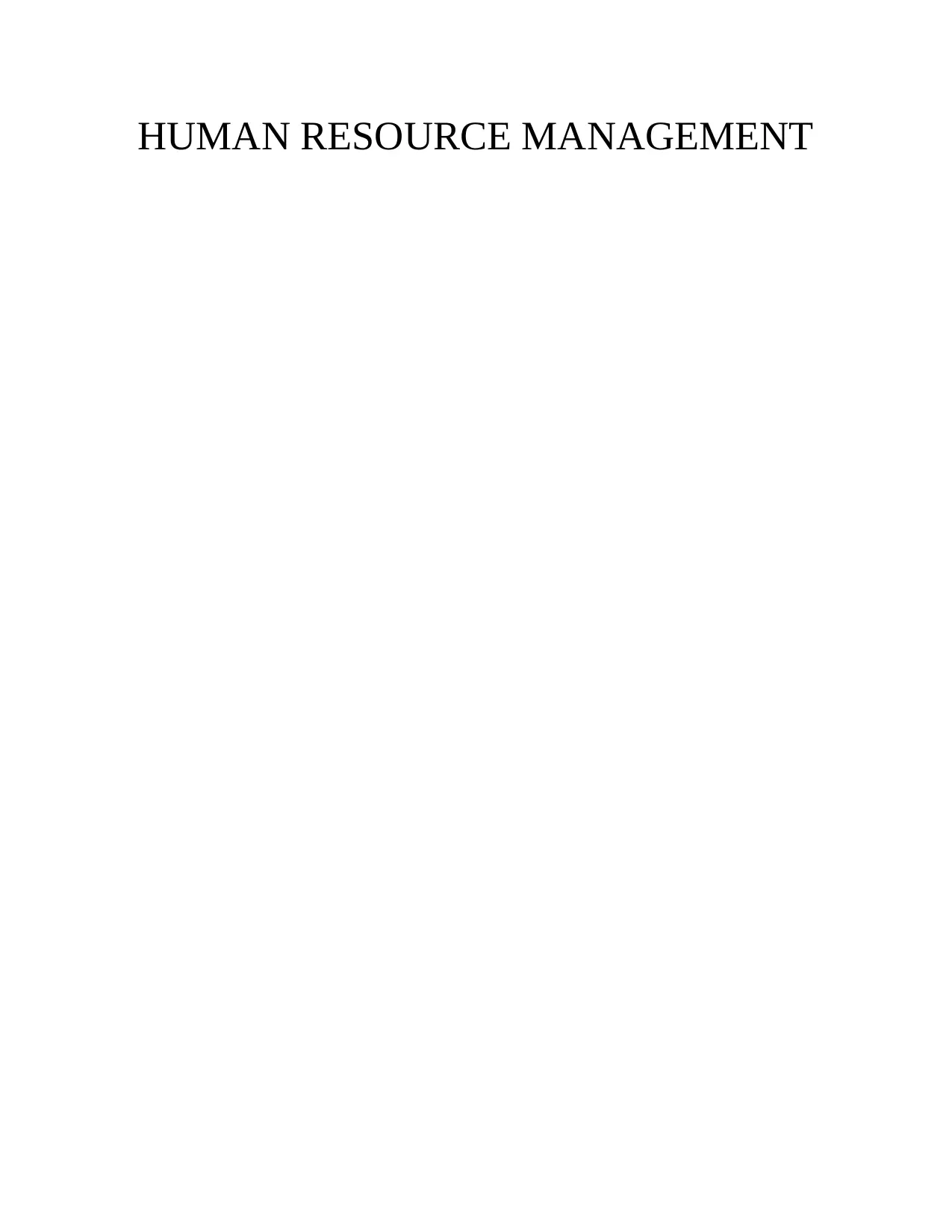
HUMAN RESOURCE MANAGEMENT
Secure Best Marks with AI Grader
Need help grading? Try our AI Grader for instant feedback on your assignments.
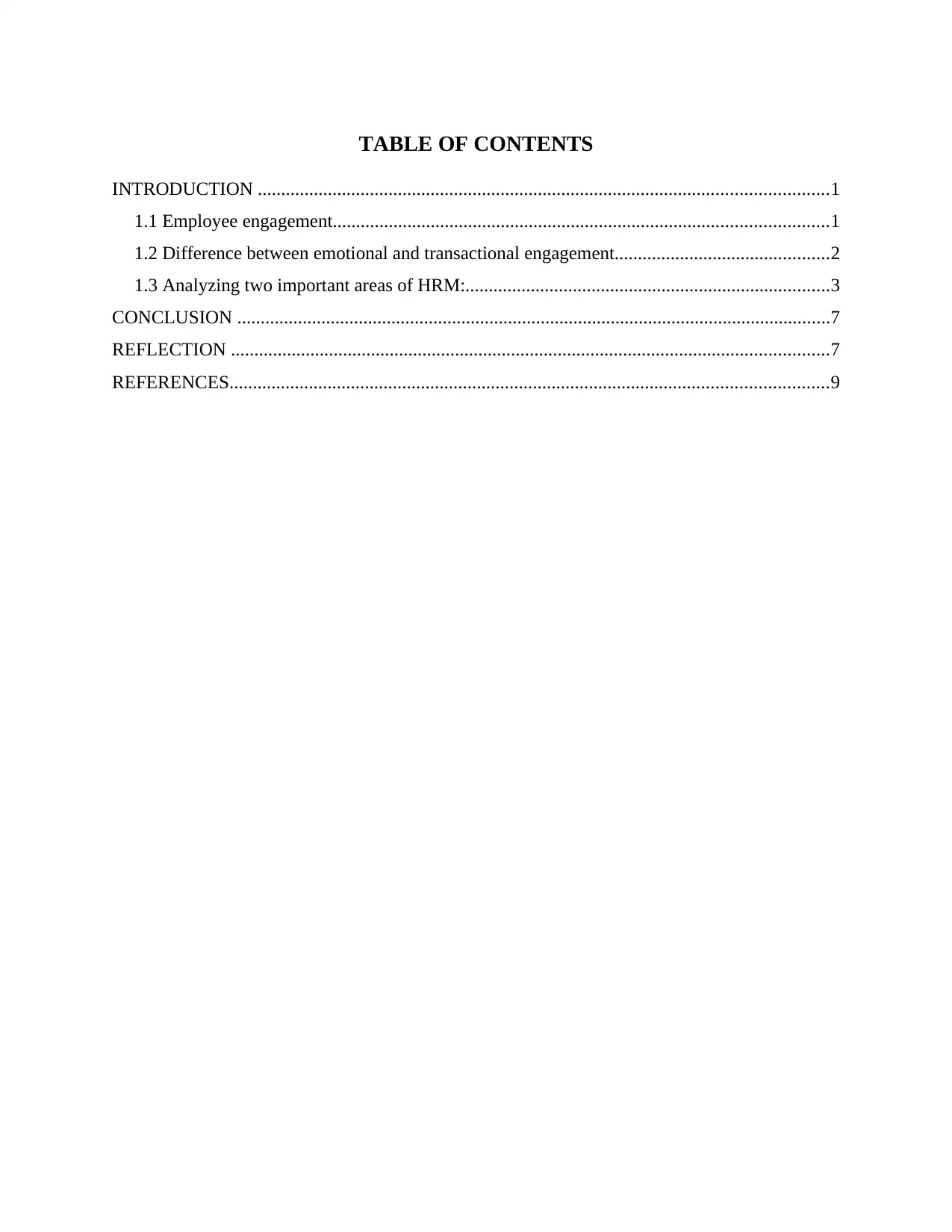
TABLE OF CONTENTS
INTRODUCTION ..........................................................................................................................1
1.1 Employee engagement..........................................................................................................1
1.2 Difference between emotional and transactional engagement..............................................2
1.3 Analyzing two important areas of HRM:..............................................................................3
CONCLUSION ...............................................................................................................................7
REFLECTION ................................................................................................................................7
REFERENCES................................................................................................................................9
INTRODUCTION ..........................................................................................................................1
1.1 Employee engagement..........................................................................................................1
1.2 Difference between emotional and transactional engagement..............................................2
1.3 Analyzing two important areas of HRM:..............................................................................3
CONCLUSION ...............................................................................................................................7
REFLECTION ................................................................................................................................7
REFERENCES................................................................................................................................9
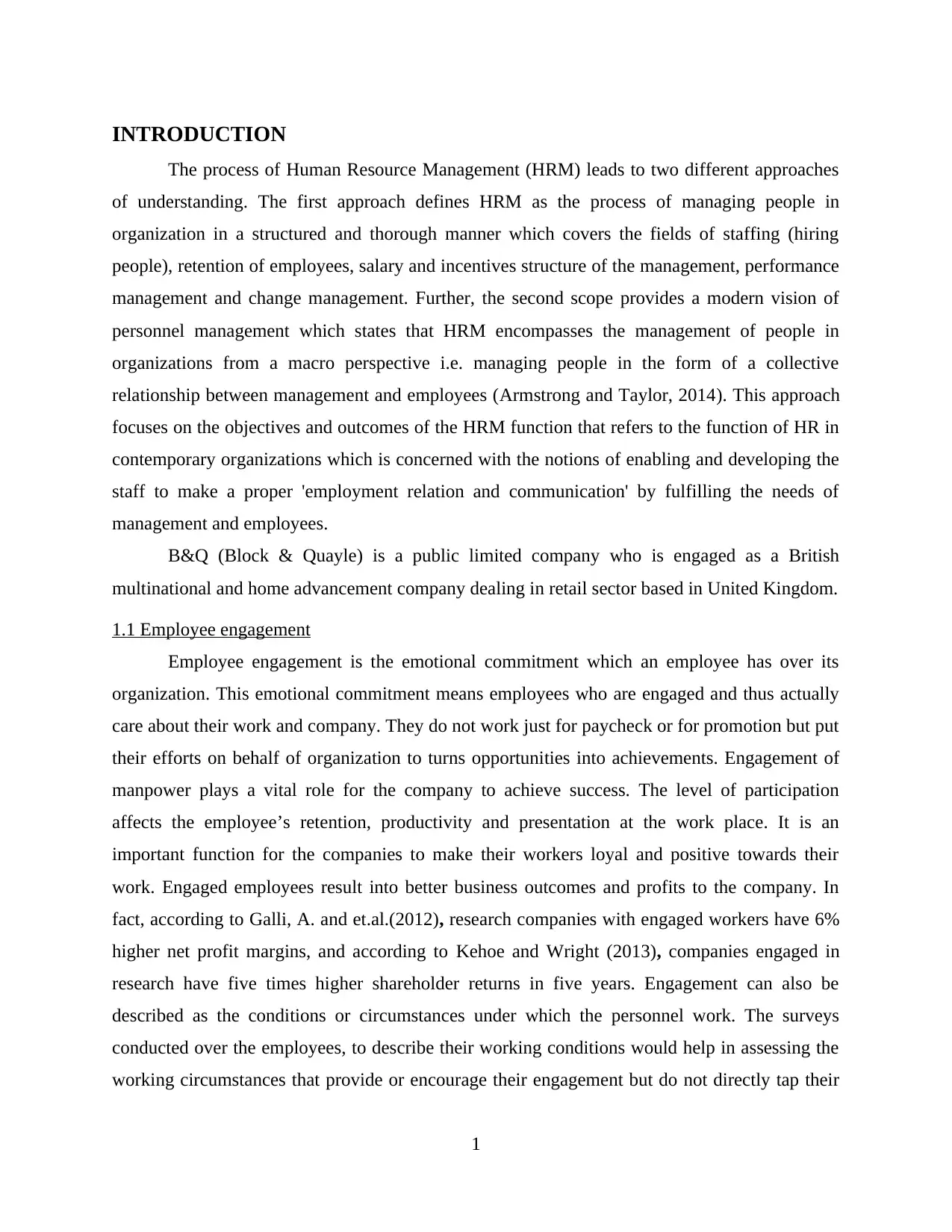
INTRODUCTION
The process of Human Resource Management (HRM) leads to two different approaches
of understanding. The first approach defines HRM as the process of managing people in
organization in a structured and thorough manner which covers the fields of staffing (hiring
people), retention of employees, salary and incentives structure of the management, performance
management and change management. Further, the second scope provides a modern vision of
personnel management which states that HRM encompasses the management of people in
organizations from a macro perspective i.e. managing people in the form of a collective
relationship between management and employees (Armstrong and Taylor, 2014). This approach
focuses on the objectives and outcomes of the HRM function that refers to the function of HR in
contemporary organizations which is concerned with the notions of enabling and developing the
staff to make a proper 'employment relation and communication' by fulfilling the needs of
management and employees.
B&Q (Block & Quayle) is a public limited company who is engaged as a British
multinational and home advancement company dealing in retail sector based in United Kingdom.
1.1 Employee engagement
Employee engagement is the emotional commitment which an employee has over its
organization. This emotional commitment means employees who are engaged and thus actually
care about their work and company. They do not work just for paycheck or for promotion but put
their efforts on behalf of organization to turns opportunities into achievements. Engagement of
manpower plays a vital role for the company to achieve success. The level of participation
affects the employee’s retention, productivity and presentation at the work place. It is an
important function for the companies to make their workers loyal and positive towards their
work. Engaged employees result into better business outcomes and profits to the company. In
fact, according to Galli, A. and et.al.(2012), research companies with engaged workers have 6%
higher net profit margins, and according to Kehoe and Wright (2013), companies engaged in
research have five times higher shareholder returns in five years. Engagement can also be
described as the conditions or circumstances under which the personnel work. The surveys
conducted over the employees, to describe their working conditions would help in assessing the
working circumstances that provide or encourage their engagement but do not directly tap their
1
The process of Human Resource Management (HRM) leads to two different approaches
of understanding. The first approach defines HRM as the process of managing people in
organization in a structured and thorough manner which covers the fields of staffing (hiring
people), retention of employees, salary and incentives structure of the management, performance
management and change management. Further, the second scope provides a modern vision of
personnel management which states that HRM encompasses the management of people in
organizations from a macro perspective i.e. managing people in the form of a collective
relationship between management and employees (Armstrong and Taylor, 2014). This approach
focuses on the objectives and outcomes of the HRM function that refers to the function of HR in
contemporary organizations which is concerned with the notions of enabling and developing the
staff to make a proper 'employment relation and communication' by fulfilling the needs of
management and employees.
B&Q (Block & Quayle) is a public limited company who is engaged as a British
multinational and home advancement company dealing in retail sector based in United Kingdom.
1.1 Employee engagement
Employee engagement is the emotional commitment which an employee has over its
organization. This emotional commitment means employees who are engaged and thus actually
care about their work and company. They do not work just for paycheck or for promotion but put
their efforts on behalf of organization to turns opportunities into achievements. Engagement of
manpower plays a vital role for the company to achieve success. The level of participation
affects the employee’s retention, productivity and presentation at the work place. It is an
important function for the companies to make their workers loyal and positive towards their
work. Engaged employees result into better business outcomes and profits to the company. In
fact, according to Galli, A. and et.al.(2012), research companies with engaged workers have 6%
higher net profit margins, and according to Kehoe and Wright (2013), companies engaged in
research have five times higher shareholder returns in five years. Engagement can also be
described as the conditions or circumstances under which the personnel work. The surveys
conducted over the employees, to describe their working conditions would help in assessing the
working circumstances that provide or encourage their engagement but do not directly tap their
1
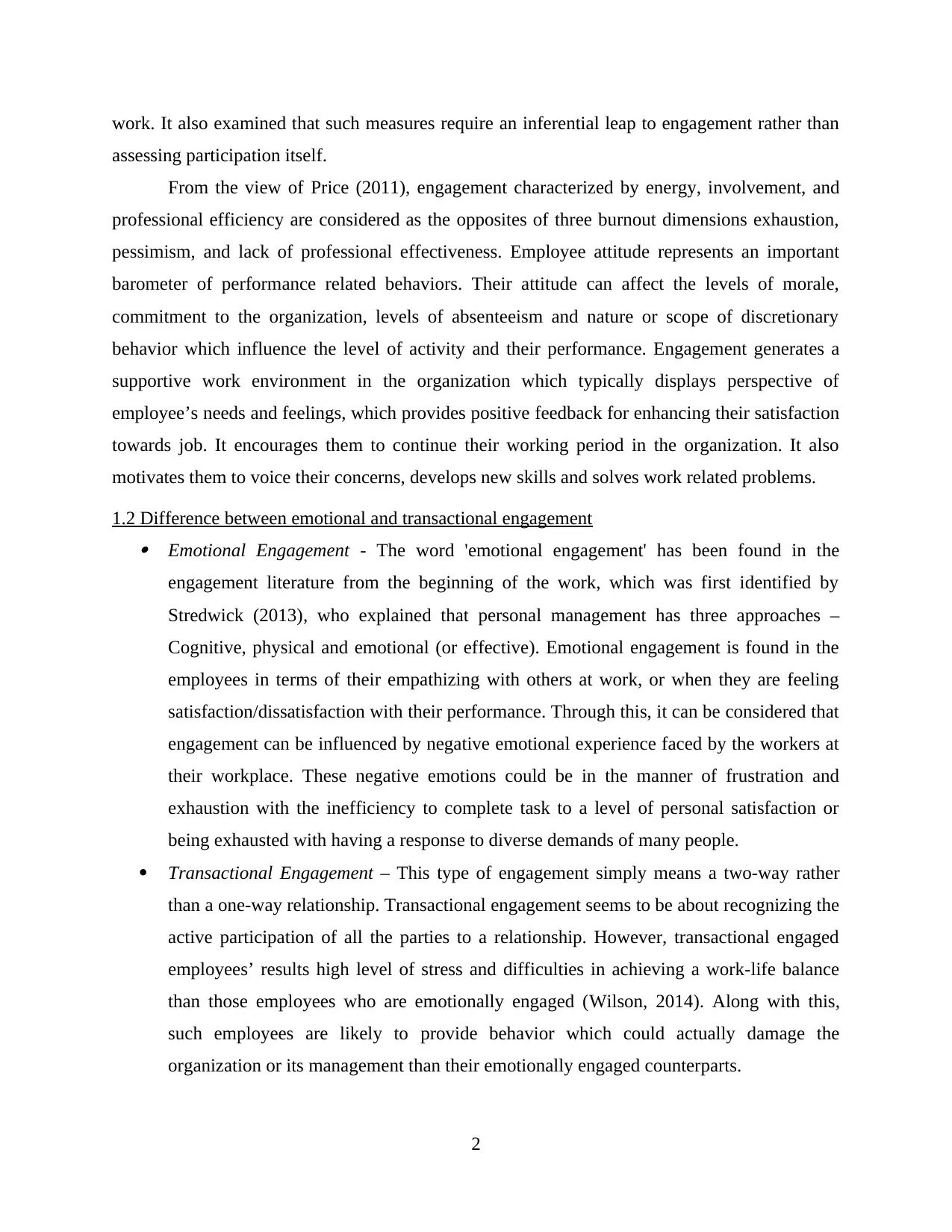
work. It also examined that such measures require an inferential leap to engagement rather than
assessing participation itself.
From the view of Price (2011), engagement characterized by energy, involvement, and
professional efficiency are considered as the opposites of three burnout dimensions exhaustion,
pessimism, and lack of professional effectiveness. Employee attitude represents an important
barometer of performance related behaviors. Their attitude can affect the levels of morale,
commitment to the organization, levels of absenteeism and nature or scope of discretionary
behavior which influence the level of activity and their performance. Engagement generates a
supportive work environment in the organization which typically displays perspective of
employee’s needs and feelings, which provides positive feedback for enhancing their satisfaction
towards job. It encourages them to continue their working period in the organization. It also
motivates them to voice their concerns, develops new skills and solves work related problems.
1.2 Difference between emotional and transactional engagement Emotional Engagement - The word 'emotional engagement' has been found in the
engagement literature from the beginning of the work, which was first identified by
Stredwick (2013), who explained that personal management has three approaches –
Cognitive, physical and emotional (or effective). Emotional engagement is found in the
employees in terms of their empathizing with others at work, or when they are feeling
satisfaction/dissatisfaction with their performance. Through this, it can be considered that
engagement can be influenced by negative emotional experience faced by the workers at
their workplace. These negative emotions could be in the manner of frustration and
exhaustion with the inefficiency to complete task to a level of personal satisfaction or
being exhausted with having a response to diverse demands of many people.
Transactional Engagement – This type of engagement simply means a two-way rather
than a one-way relationship. Transactional engagement seems to be about recognizing the
active participation of all the parties to a relationship. However, transactional engaged
employees’ results high level of stress and difficulties in achieving a work-life balance
than those employees who are emotionally engaged (Wilson, 2014). Along with this,
such employees are likely to provide behavior which could actually damage the
organization or its management than their emotionally engaged counterparts.
2
assessing participation itself.
From the view of Price (2011), engagement characterized by energy, involvement, and
professional efficiency are considered as the opposites of three burnout dimensions exhaustion,
pessimism, and lack of professional effectiveness. Employee attitude represents an important
barometer of performance related behaviors. Their attitude can affect the levels of morale,
commitment to the organization, levels of absenteeism and nature or scope of discretionary
behavior which influence the level of activity and their performance. Engagement generates a
supportive work environment in the organization which typically displays perspective of
employee’s needs and feelings, which provides positive feedback for enhancing their satisfaction
towards job. It encourages them to continue their working period in the organization. It also
motivates them to voice their concerns, develops new skills and solves work related problems.
1.2 Difference between emotional and transactional engagement Emotional Engagement - The word 'emotional engagement' has been found in the
engagement literature from the beginning of the work, which was first identified by
Stredwick (2013), who explained that personal management has three approaches –
Cognitive, physical and emotional (or effective). Emotional engagement is found in the
employees in terms of their empathizing with others at work, or when they are feeling
satisfaction/dissatisfaction with their performance. Through this, it can be considered that
engagement can be influenced by negative emotional experience faced by the workers at
their workplace. These negative emotions could be in the manner of frustration and
exhaustion with the inefficiency to complete task to a level of personal satisfaction or
being exhausted with having a response to diverse demands of many people.
Transactional Engagement – This type of engagement simply means a two-way rather
than a one-way relationship. Transactional engagement seems to be about recognizing the
active participation of all the parties to a relationship. However, transactional engaged
employees’ results high level of stress and difficulties in achieving a work-life balance
than those employees who are emotionally engaged (Wilson, 2014). Along with this,
such employees are likely to provide behavior which could actually damage the
organization or its management than their emotionally engaged counterparts.
2
Secure Best Marks with AI Grader
Need help grading? Try our AI Grader for instant feedback on your assignments.
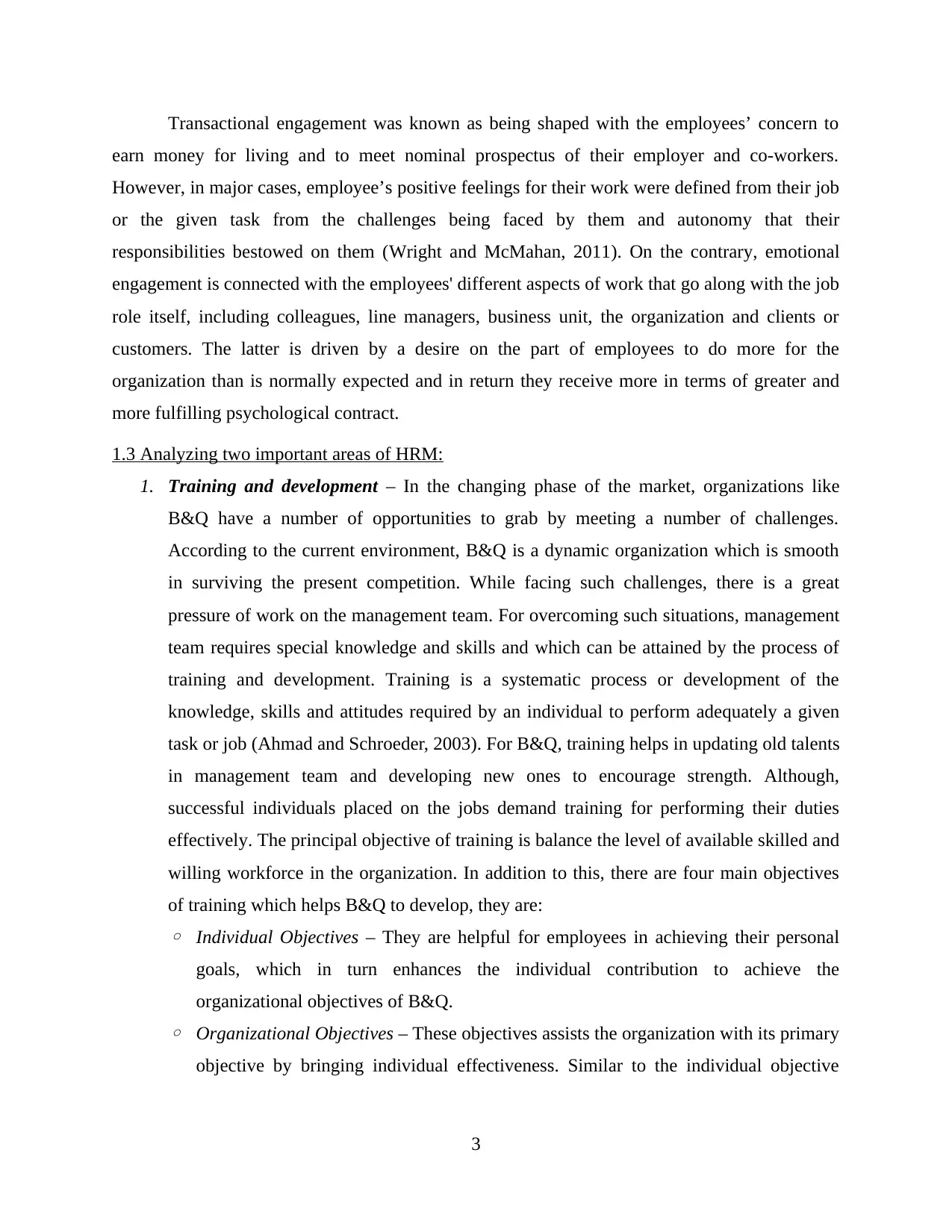
Transactional engagement was known as being shaped with the employees’ concern to
earn money for living and to meet nominal prospectus of their employer and co-workers.
However, in major cases, employee’s positive feelings for their work were defined from their job
or the given task from the challenges being faced by them and autonomy that their
responsibilities bestowed on them (Wright and McMahan, 2011). On the contrary, emotional
engagement is connected with the employees' different aspects of work that go along with the job
role itself, including colleagues, line managers, business unit, the organization and clients or
customers. The latter is driven by a desire on the part of employees to do more for the
organization than is normally expected and in return they receive more in terms of greater and
more fulfilling psychological contract.
1.3 Analyzing two important areas of HRM:
1. Training and development – In the changing phase of the market, organizations like
B&Q have a number of opportunities to grab by meeting a number of challenges.
According to the current environment, B&Q is a dynamic organization which is smooth
in surviving the present competition. While facing such challenges, there is a great
pressure of work on the management team. For overcoming such situations, management
team requires special knowledge and skills and which can be attained by the process of
training and development. Training is a systematic process or development of the
knowledge, skills and attitudes required by an individual to perform adequately a given
task or job (Ahmad and Schroeder, 2003). For B&Q, training helps in updating old talents
in management team and developing new ones to encourage strength. Although,
successful individuals placed on the jobs demand training for performing their duties
effectively. The principal objective of training is balance the level of available skilled and
willing workforce in the organization. In addition to this, there are four main objectives
of training which helps B&Q to develop, they are:
◦ Individual Objectives – They are helpful for employees in achieving their personal
goals, which in turn enhances the individual contribution to achieve the
organizational objectives of B&Q.
◦ Organizational Objectives – These objectives assists the organization with its primary
objective by bringing individual effectiveness. Similar to the individual objective
3
earn money for living and to meet nominal prospectus of their employer and co-workers.
However, in major cases, employee’s positive feelings for their work were defined from their job
or the given task from the challenges being faced by them and autonomy that their
responsibilities bestowed on them (Wright and McMahan, 2011). On the contrary, emotional
engagement is connected with the employees' different aspects of work that go along with the job
role itself, including colleagues, line managers, business unit, the organization and clients or
customers. The latter is driven by a desire on the part of employees to do more for the
organization than is normally expected and in return they receive more in terms of greater and
more fulfilling psychological contract.
1.3 Analyzing two important areas of HRM:
1. Training and development – In the changing phase of the market, organizations like
B&Q have a number of opportunities to grab by meeting a number of challenges.
According to the current environment, B&Q is a dynamic organization which is smooth
in surviving the present competition. While facing such challenges, there is a great
pressure of work on the management team. For overcoming such situations, management
team requires special knowledge and skills and which can be attained by the process of
training and development. Training is a systematic process or development of the
knowledge, skills and attitudes required by an individual to perform adequately a given
task or job (Ahmad and Schroeder, 2003). For B&Q, training helps in updating old talents
in management team and developing new ones to encourage strength. Although,
successful individuals placed on the jobs demand training for performing their duties
effectively. The principal objective of training is balance the level of available skilled and
willing workforce in the organization. In addition to this, there are four main objectives
of training which helps B&Q to develop, they are:
◦ Individual Objectives – They are helpful for employees in achieving their personal
goals, which in turn enhances the individual contribution to achieve the
organizational objectives of B&Q.
◦ Organizational Objectives – These objectives assists the organization with its primary
objective by bringing individual effectiveness. Similar to the individual objective
3
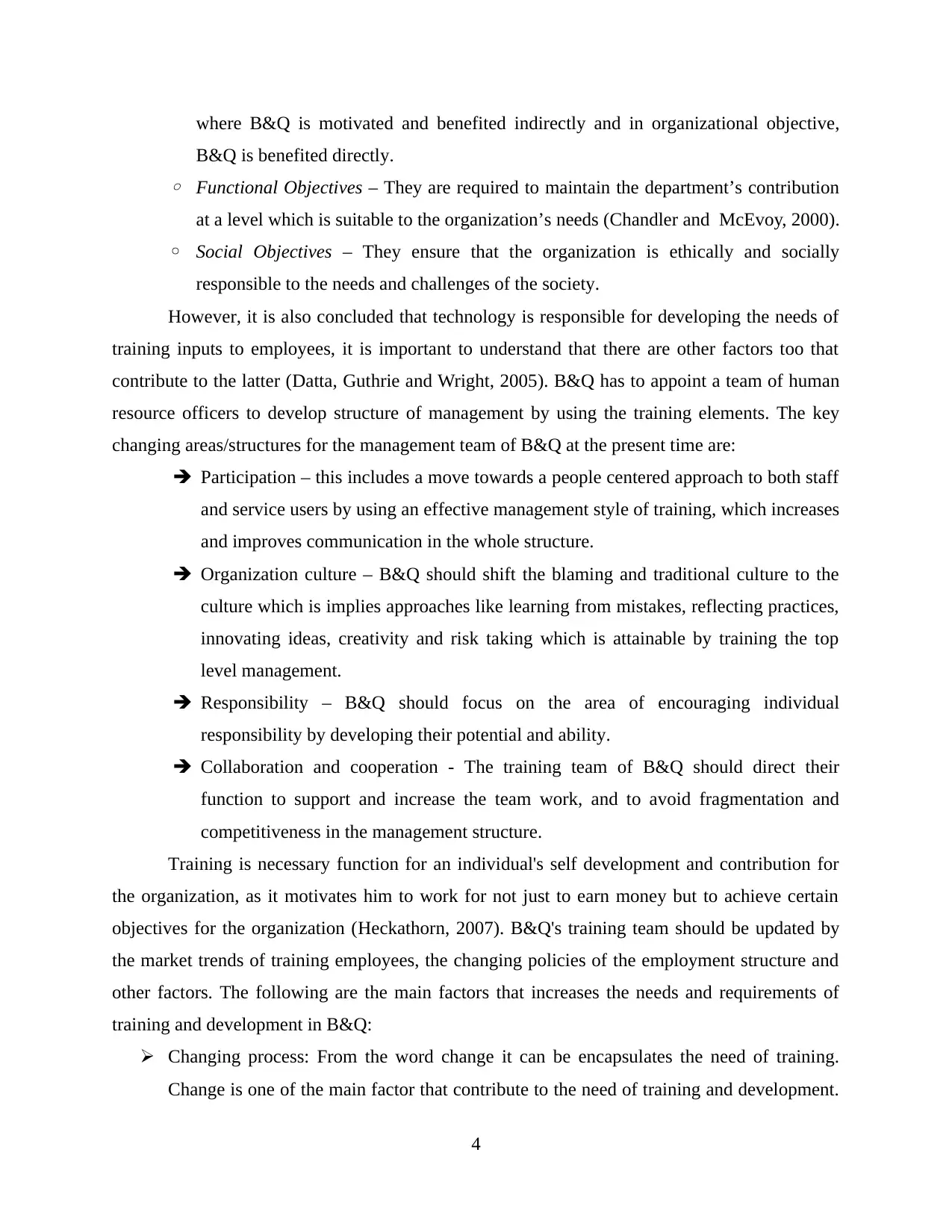
where B&Q is motivated and benefited indirectly and in organizational objective,
B&Q is benefited directly.
◦ Functional Objectives – They are required to maintain the department’s contribution
at a level which is suitable to the organization’s needs (Chandler and McEvoy, 2000).
◦ Social Objectives – They ensure that the organization is ethically and socially
responsible to the needs and challenges of the society.
However, it is also concluded that technology is responsible for developing the needs of
training inputs to employees, it is important to understand that there are other factors too that
contribute to the latter (Datta, Guthrie and Wright, 2005). B&Q has to appoint a team of human
resource officers to develop structure of management by using the training elements. The key
changing areas/structures for the management team of B&Q at the present time are:
Participation – this includes a move towards a people centered approach to both staff
and service users by using an effective management style of training, which increases
and improves communication in the whole structure.
Organization culture – B&Q should shift the blaming and traditional culture to the
culture which is implies approaches like learning from mistakes, reflecting practices,
innovating ideas, creativity and risk taking which is attainable by training the top
level management.
Responsibility – B&Q should focus on the area of encouraging individual
responsibility by developing their potential and ability.
Collaboration and cooperation - The training team of B&Q should direct their
function to support and increase the team work, and to avoid fragmentation and
competitiveness in the management structure.
Training is necessary function for an individual's self development and contribution for
the organization, as it motivates him to work for not just to earn money but to achieve certain
objectives for the organization (Heckathorn, 2007). B&Q's training team should be updated by
the market trends of training employees, the changing policies of the employment structure and
other factors. The following are the main factors that increases the needs and requirements of
training and development in B&Q:
Changing process: From the word change it can be encapsulates the need of training.
Change is one of the main factor that contribute to the need of training and development.
4
B&Q is benefited directly.
◦ Functional Objectives – They are required to maintain the department’s contribution
at a level which is suitable to the organization’s needs (Chandler and McEvoy, 2000).
◦ Social Objectives – They ensure that the organization is ethically and socially
responsible to the needs and challenges of the society.
However, it is also concluded that technology is responsible for developing the needs of
training inputs to employees, it is important to understand that there are other factors too that
contribute to the latter (Datta, Guthrie and Wright, 2005). B&Q has to appoint a team of human
resource officers to develop structure of management by using the training elements. The key
changing areas/structures for the management team of B&Q at the present time are:
Participation – this includes a move towards a people centered approach to both staff
and service users by using an effective management style of training, which increases
and improves communication in the whole structure.
Organization culture – B&Q should shift the blaming and traditional culture to the
culture which is implies approaches like learning from mistakes, reflecting practices,
innovating ideas, creativity and risk taking which is attainable by training the top
level management.
Responsibility – B&Q should focus on the area of encouraging individual
responsibility by developing their potential and ability.
Collaboration and cooperation - The training team of B&Q should direct their
function to support and increase the team work, and to avoid fragmentation and
competitiveness in the management structure.
Training is necessary function for an individual's self development and contribution for
the organization, as it motivates him to work for not just to earn money but to achieve certain
objectives for the organization (Heckathorn, 2007). B&Q's training team should be updated by
the market trends of training employees, the changing policies of the employment structure and
other factors. The following are the main factors that increases the needs and requirements of
training and development in B&Q:
Changing process: From the word change it can be encapsulates the need of training.
Change is one of the main factor that contribute to the need of training and development.
4
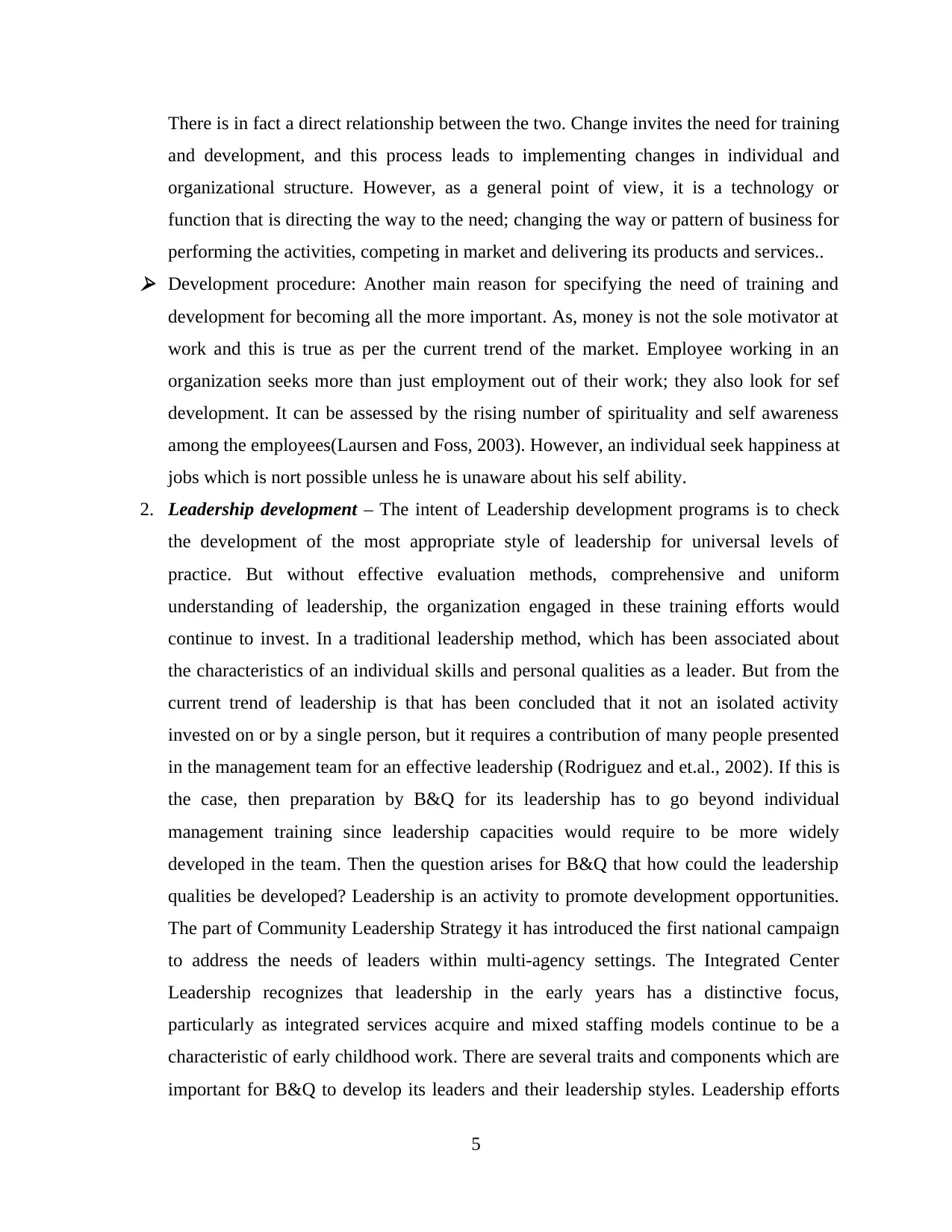
There is in fact a direct relationship between the two. Change invites the need for training
and development, and this process leads to implementing changes in individual and
organizational structure. However, as a general point of view, it is a technology or
function that is directing the way to the need; changing the way or pattern of business for
performing the activities, competing in market and delivering its products and services.. Development procedure: Another main reason for specifying the need of training and
development for becoming all the more important. As, money is not the sole motivator at
work and this is true as per the current trend of the market. Employee working in an
organization seeks more than just employment out of their work; they also look for sef
development. It can be assessed by the rising number of spirituality and self awareness
among the employees(Laursen and Foss, 2003). However, an individual seek happiness at
jobs which is nort possible unless he is unaware about his self ability.
2. Leadership development – The intent of Leadership development programs is to check
the development of the most appropriate style of leadership for universal levels of
practice. But without effective evaluation methods, comprehensive and uniform
understanding of leadership, the organization engaged in these training efforts would
continue to invest. In a traditional leadership method, which has been associated about
the characteristics of an individual skills and personal qualities as a leader. But from the
current trend of leadership is that has been concluded that it not an isolated activity
invested on or by a single person, but it requires a contribution of many people presented
in the management team for an effective leadership (Rodriguez and et.al., 2002). If this is
the case, then preparation by B&Q for its leadership has to go beyond individual
management training since leadership capacities would require to be more widely
developed in the team. Then the question arises for B&Q that how could the leadership
qualities be developed? Leadership is an activity to promote development opportunities.
The part of Community Leadership Strategy it has introduced the first national campaign
to address the needs of leaders within multi-agency settings. The Integrated Center
Leadership recognizes that leadership in the early years has a distinctive focus,
particularly as integrated services acquire and mixed staffing models continue to be a
characteristic of early childhood work. There are several traits and components which are
important for B&Q to develop its leaders and their leadership styles. Leadership efforts
5
and development, and this process leads to implementing changes in individual and
organizational structure. However, as a general point of view, it is a technology or
function that is directing the way to the need; changing the way or pattern of business for
performing the activities, competing in market and delivering its products and services.. Development procedure: Another main reason for specifying the need of training and
development for becoming all the more important. As, money is not the sole motivator at
work and this is true as per the current trend of the market. Employee working in an
organization seeks more than just employment out of their work; they also look for sef
development. It can be assessed by the rising number of spirituality and self awareness
among the employees(Laursen and Foss, 2003). However, an individual seek happiness at
jobs which is nort possible unless he is unaware about his self ability.
2. Leadership development – The intent of Leadership development programs is to check
the development of the most appropriate style of leadership for universal levels of
practice. But without effective evaluation methods, comprehensive and uniform
understanding of leadership, the organization engaged in these training efforts would
continue to invest. In a traditional leadership method, which has been associated about
the characteristics of an individual skills and personal qualities as a leader. But from the
current trend of leadership is that has been concluded that it not an isolated activity
invested on or by a single person, but it requires a contribution of many people presented
in the management team for an effective leadership (Rodriguez and et.al., 2002). If this is
the case, then preparation by B&Q for its leadership has to go beyond individual
management training since leadership capacities would require to be more widely
developed in the team. Then the question arises for B&Q that how could the leadership
qualities be developed? Leadership is an activity to promote development opportunities.
The part of Community Leadership Strategy it has introduced the first national campaign
to address the needs of leaders within multi-agency settings. The Integrated Center
Leadership recognizes that leadership in the early years has a distinctive focus,
particularly as integrated services acquire and mixed staffing models continue to be a
characteristic of early childhood work. There are several traits and components which are
important for B&Q to develop its leaders and their leadership styles. Leadership efforts
5
Paraphrase This Document
Need a fresh take? Get an instant paraphrase of this document with our AI Paraphraser
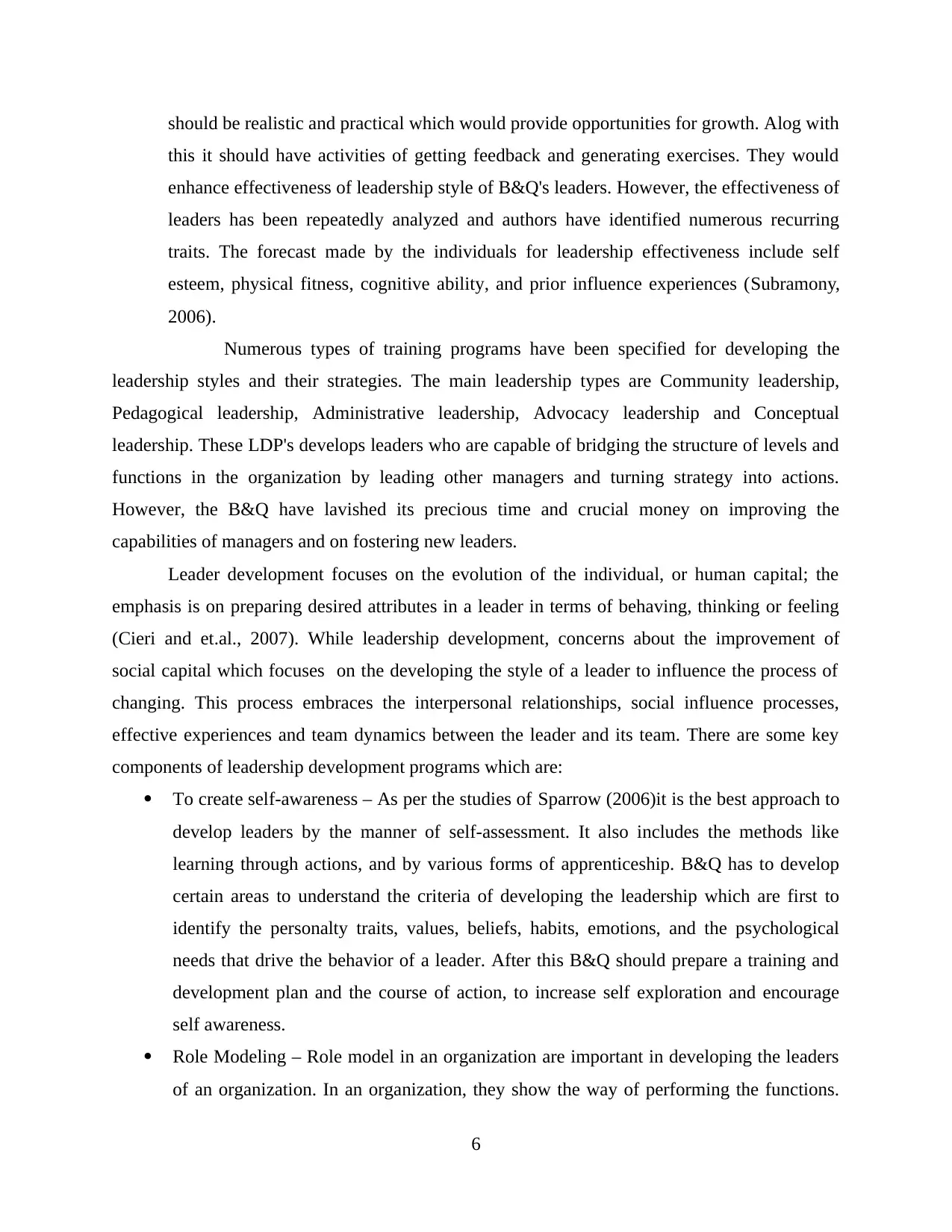
should be realistic and practical which would provide opportunities for growth. Alog with
this it should have activities of getting feedback and generating exercises. They would
enhance effectiveness of leadership style of B&Q's leaders. However, the effectiveness of
leaders has been repeatedly analyzed and authors have identified numerous recurring
traits. The forecast made by the individuals for leadership effectiveness include self
esteem, physical fitness, cognitive ability, and prior influence experiences (Subramony,
2006).
Numerous types of training programs have been specified for developing the
leadership styles and their strategies. The main leadership types are Community leadership,
Pedagogical leadership, Administrative leadership, Advocacy leadership and Conceptual
leadership. These LDP's develops leaders who are capable of bridging the structure of levels and
functions in the organization by leading other managers and turning strategy into actions.
However, the B&Q have lavished its precious time and crucial money on improving the
capabilities of managers and on fostering new leaders.
Leader development focuses on the evolution of the individual, or human capital; the
emphasis is on preparing desired attributes in a leader in terms of behaving, thinking or feeling
(Cieri and et.al., 2007). While leadership development, concerns about the improvement of
social capital which focuses on the developing the style of a leader to influence the process of
changing. This process embraces the interpersonal relationships, social influence processes,
effective experiences and team dynamics between the leader and its team. There are some key
components of leadership development programs which are:
To create self-awareness – As per the studies of Sparrow (2006)it is the best approach to
develop leaders by the manner of self-assessment. It also includes the methods like
learning through actions, and by various forms of apprenticeship. B&Q has to develop
certain areas to understand the criteria of developing the leadership which are first to
identify the personalty traits, values, beliefs, habits, emotions, and the psychological
needs that drive the behavior of a leader. After this B&Q should prepare a training and
development plan and the course of action, to increase self exploration and encourage
self awareness.
Role Modeling – Role model in an organization are important in developing the leaders
of an organization. In an organization, they show the way of performing the functions.
6
this it should have activities of getting feedback and generating exercises. They would
enhance effectiveness of leadership style of B&Q's leaders. However, the effectiveness of
leaders has been repeatedly analyzed and authors have identified numerous recurring
traits. The forecast made by the individuals for leadership effectiveness include self
esteem, physical fitness, cognitive ability, and prior influence experiences (Subramony,
2006).
Numerous types of training programs have been specified for developing the
leadership styles and their strategies. The main leadership types are Community leadership,
Pedagogical leadership, Administrative leadership, Advocacy leadership and Conceptual
leadership. These LDP's develops leaders who are capable of bridging the structure of levels and
functions in the organization by leading other managers and turning strategy into actions.
However, the B&Q have lavished its precious time and crucial money on improving the
capabilities of managers and on fostering new leaders.
Leader development focuses on the evolution of the individual, or human capital; the
emphasis is on preparing desired attributes in a leader in terms of behaving, thinking or feeling
(Cieri and et.al., 2007). While leadership development, concerns about the improvement of
social capital which focuses on the developing the style of a leader to influence the process of
changing. This process embraces the interpersonal relationships, social influence processes,
effective experiences and team dynamics between the leader and its team. There are some key
components of leadership development programs which are:
To create self-awareness – As per the studies of Sparrow (2006)it is the best approach to
develop leaders by the manner of self-assessment. It also includes the methods like
learning through actions, and by various forms of apprenticeship. B&Q has to develop
certain areas to understand the criteria of developing the leadership which are first to
identify the personalty traits, values, beliefs, habits, emotions, and the psychological
needs that drive the behavior of a leader. After this B&Q should prepare a training and
development plan and the course of action, to increase self exploration and encourage
self awareness.
Role Modeling – Role model in an organization are important in developing the leaders
of an organization. In an organization, they show the way of performing the functions.
6
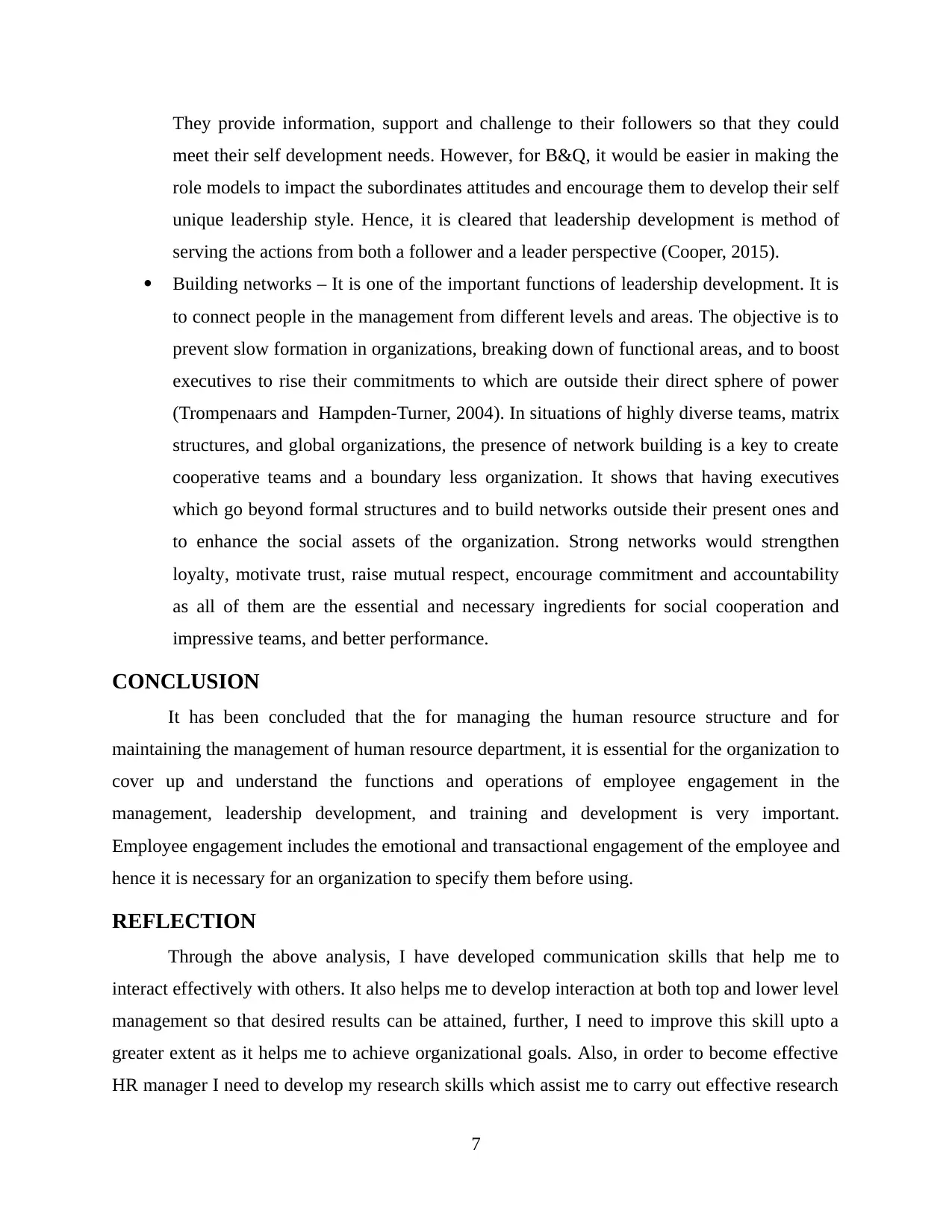
They provide information, support and challenge to their followers so that they could
meet their self development needs. However, for B&Q, it would be easier in making the
role models to impact the subordinates attitudes and encourage them to develop their self
unique leadership style. Hence, it is cleared that leadership development is method of
serving the actions from both a follower and a leader perspective (Cooper, 2015).
Building networks – It is one of the important functions of leadership development. It is
to connect people in the management from different levels and areas. The objective is to
prevent slow formation in organizations, breaking down of functional areas, and to boost
executives to rise their commitments to which are outside their direct sphere of power
(Trompenaars and Hampden-Turner, 2004). In situations of highly diverse teams, matrix
structures, and global organizations, the presence of network building is a key to create
cooperative teams and a boundary less organization. It shows that having executives
which go beyond formal structures and to build networks outside their present ones and
to enhance the social assets of the organization. Strong networks would strengthen
loyalty, motivate trust, raise mutual respect, encourage commitment and accountability
as all of them are the essential and necessary ingredients for social cooperation and
impressive teams, and better performance.
CONCLUSION
It has been concluded that the for managing the human resource structure and for
maintaining the management of human resource department, it is essential for the organization to
cover up and understand the functions and operations of employee engagement in the
management, leadership development, and training and development is very important.
Employee engagement includes the emotional and transactional engagement of the employee and
hence it is necessary for an organization to specify them before using.
REFLECTION
Through the above analysis, I have developed communication skills that help me to
interact effectively with others. It also helps me to develop interaction at both top and lower level
management so that desired results can be attained, further, I need to improve this skill upto a
greater extent as it helps me to achieve organizational goals. Also, in order to become effective
HR manager I need to develop my research skills which assist me to carry out effective research
7
meet their self development needs. However, for B&Q, it would be easier in making the
role models to impact the subordinates attitudes and encourage them to develop their self
unique leadership style. Hence, it is cleared that leadership development is method of
serving the actions from both a follower and a leader perspective (Cooper, 2015).
Building networks – It is one of the important functions of leadership development. It is
to connect people in the management from different levels and areas. The objective is to
prevent slow formation in organizations, breaking down of functional areas, and to boost
executives to rise their commitments to which are outside their direct sphere of power
(Trompenaars and Hampden-Turner, 2004). In situations of highly diverse teams, matrix
structures, and global organizations, the presence of network building is a key to create
cooperative teams and a boundary less organization. It shows that having executives
which go beyond formal structures and to build networks outside their present ones and
to enhance the social assets of the organization. Strong networks would strengthen
loyalty, motivate trust, raise mutual respect, encourage commitment and accountability
as all of them are the essential and necessary ingredients for social cooperation and
impressive teams, and better performance.
CONCLUSION
It has been concluded that the for managing the human resource structure and for
maintaining the management of human resource department, it is essential for the organization to
cover up and understand the functions and operations of employee engagement in the
management, leadership development, and training and development is very important.
Employee engagement includes the emotional and transactional engagement of the employee and
hence it is necessary for an organization to specify them before using.
REFLECTION
Through the above analysis, I have developed communication skills that help me to
interact effectively with others. It also helps me to develop interaction at both top and lower level
management so that desired results can be attained, further, I need to improve this skill upto a
greater extent as it helps me to achieve organizational goals. Also, in order to become effective
HR manager I need to develop my research skills which assist me to carry out effective research
7
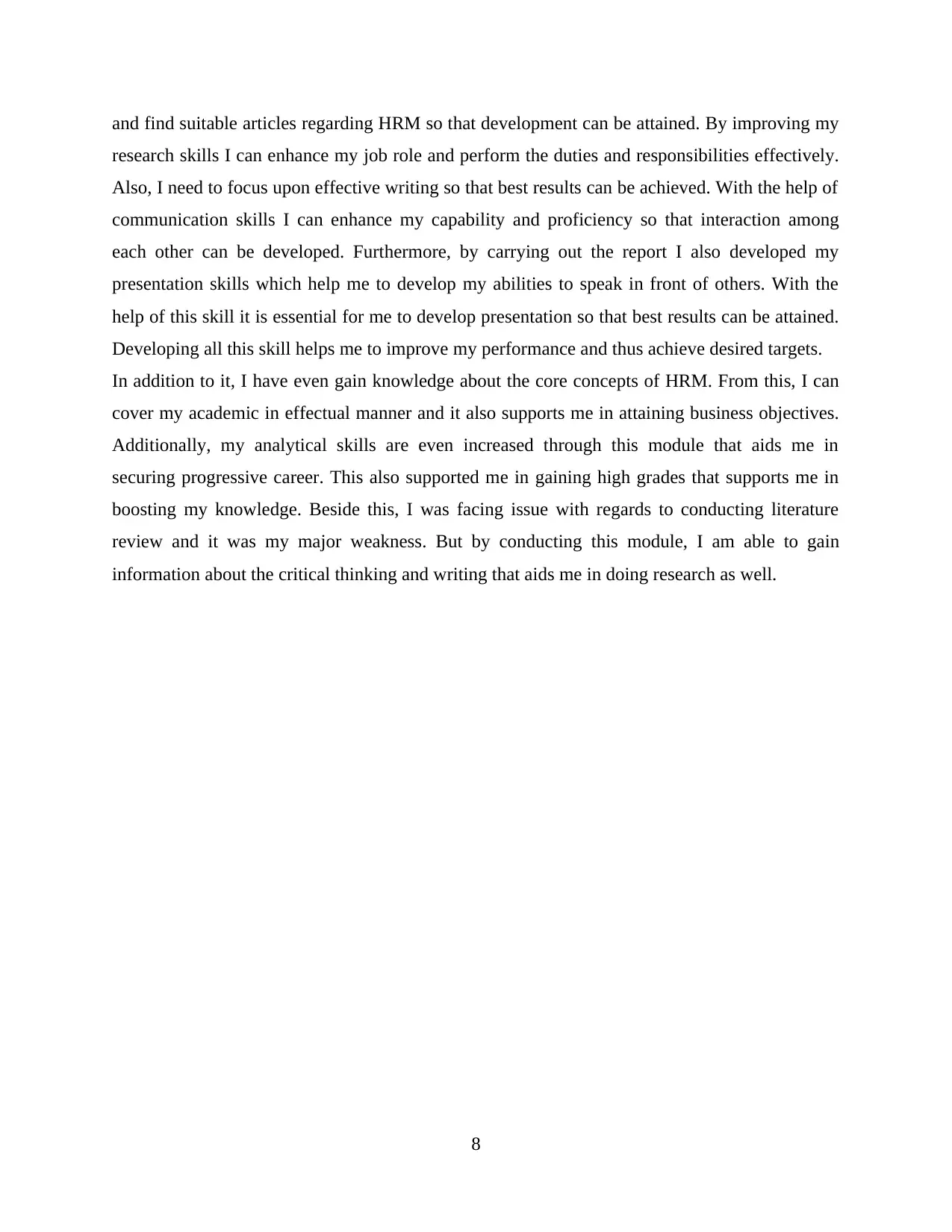
and find suitable articles regarding HRM so that development can be attained. By improving my
research skills I can enhance my job role and perform the duties and responsibilities effectively.
Also, I need to focus upon effective writing so that best results can be achieved. With the help of
communication skills I can enhance my capability and proficiency so that interaction among
each other can be developed. Furthermore, by carrying out the report I also developed my
presentation skills which help me to develop my abilities to speak in front of others. With the
help of this skill it is essential for me to develop presentation so that best results can be attained.
Developing all this skill helps me to improve my performance and thus achieve desired targets.
In addition to it, I have even gain knowledge about the core concepts of HRM. From this, I can
cover my academic in effectual manner and it also supports me in attaining business objectives.
Additionally, my analytical skills are even increased through this module that aids me in
securing progressive career. This also supported me in gaining high grades that supports me in
boosting my knowledge. Beside this, I was facing issue with regards to conducting literature
review and it was my major weakness. But by conducting this module, I am able to gain
information about the critical thinking and writing that aids me in doing research as well.
8
research skills I can enhance my job role and perform the duties and responsibilities effectively.
Also, I need to focus upon effective writing so that best results can be achieved. With the help of
communication skills I can enhance my capability and proficiency so that interaction among
each other can be developed. Furthermore, by carrying out the report I also developed my
presentation skills which help me to develop my abilities to speak in front of others. With the
help of this skill it is essential for me to develop presentation so that best results can be attained.
Developing all this skill helps me to improve my performance and thus achieve desired targets.
In addition to it, I have even gain knowledge about the core concepts of HRM. From this, I can
cover my academic in effectual manner and it also supports me in attaining business objectives.
Additionally, my analytical skills are even increased through this module that aids me in
securing progressive career. This also supported me in gaining high grades that supports me in
boosting my knowledge. Beside this, I was facing issue with regards to conducting literature
review and it was my major weakness. But by conducting this module, I am able to gain
information about the critical thinking and writing that aids me in doing research as well.
8
Secure Best Marks with AI Grader
Need help grading? Try our AI Grader for instant feedback on your assignments.
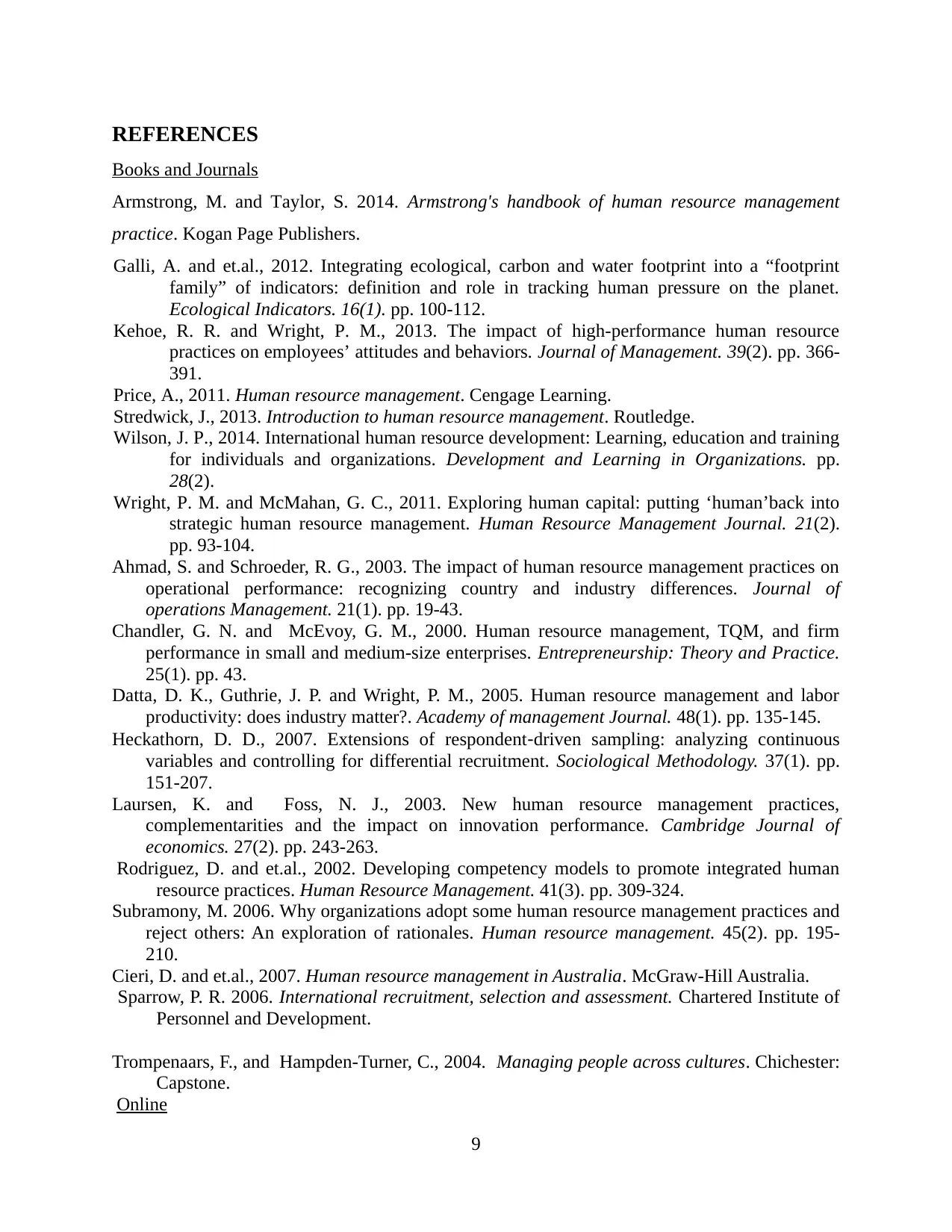
REFERENCES
Books and Journals
Armstrong, M. and Taylor, S. 2014. Armstrong's handbook of human resource management
practice. Kogan Page Publishers.
Galli, A. and et.al., 2012. Integrating ecological, carbon and water footprint into a “footprint
family” of indicators: definition and role in tracking human pressure on the planet.
Ecological Indicators. 16(1). pp. 100-112.
Kehoe, R. R. and Wright, P. M., 2013. The impact of high-performance human resource
practices on employees’ attitudes and behaviors. Journal of Management. 39(2). pp. 366-
391.
Price, A., 2011. Human resource management. Cengage Learning.
Stredwick, J., 2013. Introduction to human resource management. Routledge.
Wilson, J. P., 2014. International human resource development: Learning, education and training
for individuals and organizations. Development and Learning in Organizations. pp.
28(2).
Wright, P. M. and McMahan, G. C., 2011. Exploring human capital: putting ‘human’back into
strategic human resource management. Human Resource Management Journal. 21(2).
pp. 93-104.
Ahmad, S. and Schroeder, R. G., 2003. The impact of human resource management practices on
operational performance: recognizing country and industry differences. Journal of
operations Management. 21(1). pp. 19-43.
Chandler, G. N. and McEvoy, G. M., 2000. Human resource management, TQM, and firm
performance in small and medium-size enterprises. Entrepreneurship: Theory and Practice.
25(1). pp. 43.
Datta, D. K., Guthrie, J. P. and Wright, P. M., 2005. Human resource management and labor
productivity: does industry matter?. Academy of management Journal. 48(1). pp. 135-145.
Heckathorn, D. D., 2007. Extensions of respondent‐driven sampling: analyzing continuous
variables and controlling for differential recruitment. Sociological Methodology. 37(1). pp.
151-207.
Laursen, K. and Foss, N. J., 2003. New human resource management practices,
complementarities and the impact on innovation performance. Cambridge Journal of
economics. 27(2). pp. 243-263.
Rodriguez, D. and et.al., 2002. Developing competency models to promote integrated human
resource practices. Human Resource Management. 41(3). pp. 309-324.
Subramony, M. 2006. Why organizations adopt some human resource management practices and
reject others: An exploration of rationales. Human resource management. 45(2). pp. 195-
210.
Cieri, D. and et.al., 2007. Human resource management in Australia. McGraw-Hill Australia.
Sparrow, P. R. 2006. International recruitment, selection and assessment. Chartered Institute of
Personnel and Development.
Trompenaars, F., and Hampden-Turner, C., 2004. Managing people across cultures. Chichester:
Capstone.
Online
9
Books and Journals
Armstrong, M. and Taylor, S. 2014. Armstrong's handbook of human resource management
practice. Kogan Page Publishers.
Galli, A. and et.al., 2012. Integrating ecological, carbon and water footprint into a “footprint
family” of indicators: definition and role in tracking human pressure on the planet.
Ecological Indicators. 16(1). pp. 100-112.
Kehoe, R. R. and Wright, P. M., 2013. The impact of high-performance human resource
practices on employees’ attitudes and behaviors. Journal of Management. 39(2). pp. 366-
391.
Price, A., 2011. Human resource management. Cengage Learning.
Stredwick, J., 2013. Introduction to human resource management. Routledge.
Wilson, J. P., 2014. International human resource development: Learning, education and training
for individuals and organizations. Development and Learning in Organizations. pp.
28(2).
Wright, P. M. and McMahan, G. C., 2011. Exploring human capital: putting ‘human’back into
strategic human resource management. Human Resource Management Journal. 21(2).
pp. 93-104.
Ahmad, S. and Schroeder, R. G., 2003. The impact of human resource management practices on
operational performance: recognizing country and industry differences. Journal of
operations Management. 21(1). pp. 19-43.
Chandler, G. N. and McEvoy, G. M., 2000. Human resource management, TQM, and firm
performance in small and medium-size enterprises. Entrepreneurship: Theory and Practice.
25(1). pp. 43.
Datta, D. K., Guthrie, J. P. and Wright, P. M., 2005. Human resource management and labor
productivity: does industry matter?. Academy of management Journal. 48(1). pp. 135-145.
Heckathorn, D. D., 2007. Extensions of respondent‐driven sampling: analyzing continuous
variables and controlling for differential recruitment. Sociological Methodology. 37(1). pp.
151-207.
Laursen, K. and Foss, N. J., 2003. New human resource management practices,
complementarities and the impact on innovation performance. Cambridge Journal of
economics. 27(2). pp. 243-263.
Rodriguez, D. and et.al., 2002. Developing competency models to promote integrated human
resource practices. Human Resource Management. 41(3). pp. 309-324.
Subramony, M. 2006. Why organizations adopt some human resource management practices and
reject others: An exploration of rationales. Human resource management. 45(2). pp. 195-
210.
Cieri, D. and et.al., 2007. Human resource management in Australia. McGraw-Hill Australia.
Sparrow, P. R. 2006. International recruitment, selection and assessment. Chartered Institute of
Personnel and Development.
Trompenaars, F., and Hampden-Turner, C., 2004. Managing people across cultures. Chichester:
Capstone.
Online
9
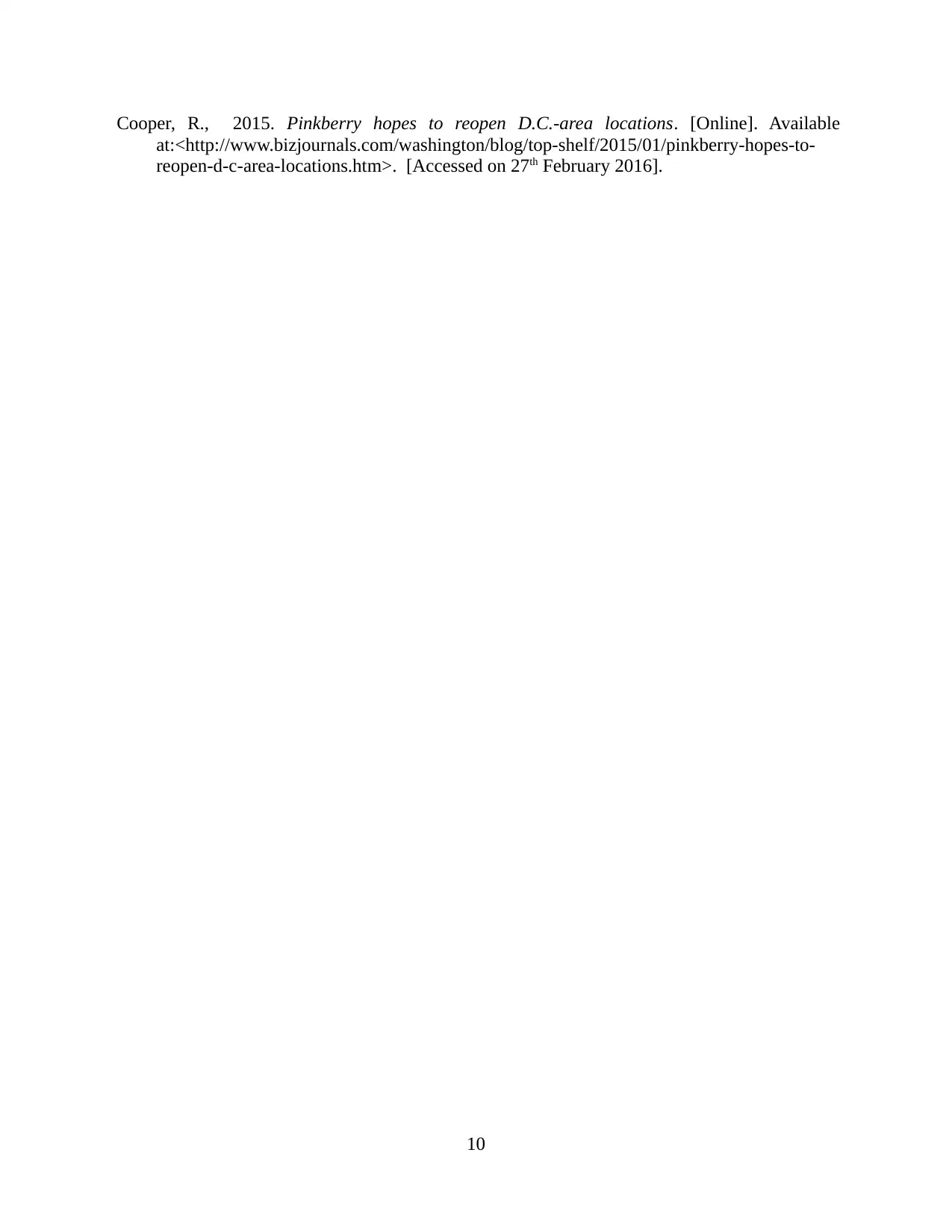
Cooper, R., 2015. Pinkberry hopes to reopen D.C.-area locations. [Online]. Available
at:<http://www.bizjournals.com/washington/blog/top-shelf/2015/01/pinkberry-hopes-to-
reopen-d-c-area-locations.htm>. [Accessed on 27th February 2016].
10
at:<http://www.bizjournals.com/washington/blog/top-shelf/2015/01/pinkberry-hopes-to-
reopen-d-c-area-locations.htm>. [Accessed on 27th February 2016].
10
1 out of 12
Related Documents
Your All-in-One AI-Powered Toolkit for Academic Success.
+13062052269
info@desklib.com
Available 24*7 on WhatsApp / Email
![[object Object]](/_next/static/media/star-bottom.7253800d.svg)
Unlock your academic potential
© 2024 | Zucol Services PVT LTD | All rights reserved.





